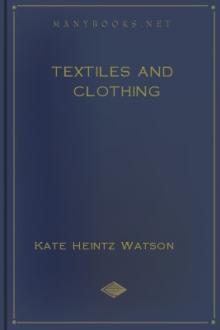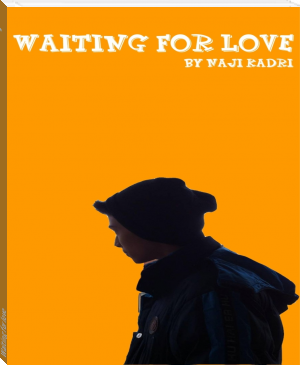Textiles and Clothing, Kate Heintz Watson [best ebook reader for laptop .txt] 📗

- Author: Kate Heintz Watson
- Performer: -
Book online «Textiles and Clothing, Kate Heintz Watson [best ebook reader for laptop .txt] 📗». Author Kate Heintz Watson
In making a cloth with plain weave, that is, with every thread interlacing with every other, as in darning, only two harnesses are required, but the modern loom may have up to about twenty-four harnesses so that an infinite variety of weaves may be obtained. Various cams and levers move the harness frame and so raise or lower the threads required for the design.
The Jacquard loom is arranged on a different principle. In this loom, all kinds of fancy weaves may be obtained as in table linen, tapestries and carpets. Each warp thread is supplied with a separate hook and by means of perforated card the desired threads are raised or depressed at each throw of the shuttle. The cards are worked out by the designer. A set of a thousand or more cards may be required to produce the desired design. Jacquard looms are sometimes to be seen at fairs and expositions weaving handkerchiefs with some picture design.
The great variety of weaves found in the textiles of to-day are modifications of a few fundamental weaves invented in the earliest times.
The chief fundamental weaves are:
(2) Twills.
(3) Sateen.
To which may be added the derivatives—
(5) Basket weave.
These do not include the many fancy weaves, too numerous to classify, and the open work weaves, made in the Leno loom, in which some of the threads are crossed. Knit goods are made by the interlooping of a single thread, by hand or on circular knitting machines and lace by an analogous process, using several systems of threads. Felt is made up of matted fibers of fur and wool and has no thread structure.
The plain weave is the most common, nearly all light weight goods being thus woven. In plain weaving, each thread of both warp and filling passes alternately over and under the threads at right angles. This makes a comparatively open cloth, requiring the smallest amount of yarn for the surface covered. This weave is used in nearly all cotton goods, as in muslins, sheetings, calicoes, ginghams, and thin woolen goods. Even in the plain weave variety is obtained by having some of the threads larger than others, either in warp or filling or both, thus producing stripes and checked effects.
After the plain weave the twill is the most common, being much used for dress goods, suitings, etc., as well as some of the thicker cottons. In this weave the intersections of the threads produce characteristic lines diagonally across the fabric, most often at an angle of 45°. The twill may be hardly visible or very pronounced. The simplest twills are the so-called "doeskin" and "prunella." In the doeskin the filling threads pass over one and under two of the warp threads and in the prunella twill over two and under one. The most common twill is the cassimere twill in which both the warp and filling run over two and under two of the threads at right angles.
A twill made by running both warp and filling under one and over three threads is called a swansdown twill and the reverse is known as the crow weave. In these the diagonal twilled effect is much more marked. Various twills are often combined with each other and with plain weave, making a great variety of texture. Numerous uneven twills are made, two over and three under, etc., etc.
In the sateen weave, nearly all of either the warp or the filling threads are on the surface, the object being to produce a smooth surface fabric like sateen. With this weave it is possible to use a cotton warp and silk filling, having most of the silk appear on the surface of the fabric.
The rib and basket weaves are derivatives of the plain weave, two or more threads replacing the single strand. In the rib weave, either the warp or the filling threads run double or more, thus making a corded effect. In the basket weave, both warp and filling are run double or treble, giving a coarse texture. This weave is sometimes called the panama weave.
In the thicker fabrics like men's suitings and overcoatings, there may be a double series of warp threads, only one series appearing on the face of the goods, and in the still thicker fabrics, there may be a double set of both warp and filling threads, making double cloth, the two sides of which may be entirely different in color and design.
In weaving plush, velvet and velveteen, loops are made in the filling or warp threads which are afterwards cut, producing the pile.
BLEACHING, DYEING, PRINTING, FINISHINGWhen the cloth comes from the loom it is by no means ready for the market. Nearly all kinds are washed and pressed and in some classes of goods the finishing process is very elaborate.
BLEACHING AND DYEINGThe fiber may be dyed in a loose or unspun state, as is customary with wool; after it has been spun and is in the form of yarn, as in the case of silk and linen; and when it has been woven to form cloth, as is most commonly the case with cotton.
The bleaching of cotton involves a number of steps, the most thorough process being called the "madder bleach," in which the cloth is (1) wet out, (2) boiled with lime water, (3) rinsed, (4) treated with acid, (5) rinsed, (6) boiled with soap and alkali, (7) rinsed, (8) treated with bleaching powder solution, (9) rinsed, (10) treated with acid, (11) finally rinsed again. All this is done by machines and hundreds of yards go through the process at a time. The product is a pure white cloth suitable for dyeing light shades and for white goods. When cloth is to be dyed a dark shade the treatment is less elaborate.
If the cloth is to be printed for calicoes, before bleaching it is singed by passing through gas flames or over a red hot plate and then sheared in a shearing machine constructed somewhat on the principle of the lawn mower, the cloth being run close to the rapidly revolving knives.
Although cotton is usually dyed in the piece, it may be dyed in the form of yarn, as for ginghams, and sometimes before being woven, in the loose state.
Cotton is more difficult to dye than wool or silk. Although there are now what are called "direct" cotton colors, the usual process is to first treat the cotton goods with a "mordant"—various salts of aluminum, chromium, iron, tin and copper, fixing these on the fiber by means of tannin or alkali. The mordanted cloth is then entered into the dye bath and boiled for an hour or longer, until the desired shade is obtained or the dye bath exhausted. The salts of aluminum are used as mordants for the lighter shades, the salts of chromium for the medium shades, and iron for the dark shades. In general, chromium mordants give the fastest dyes.
The discovery of the so-called aniline dyes has greatly increased the variety of colors available. Although some of the first aniline dyes to be made were not fast to washing or to light and they thus received a bad reputation, they are now to be obtained which compare favorably in fastness with the natural dye stuffs such as cochineal, madder, etc., provided sufficient time and care are given to dyeing. The chief trouble is that in the endeavor to furnish cheap goods, processes are hurried and results are unsatisfactory.
Home dyeing is practically confined to the use of direct aniline colors. These are put up in small quantities and sold in many places. Directions for their use are given on the packages. The chief precautions are to have the goods perfectly clean and thoroughly wet before entering into the dye bath (this is by no means as easy as one might think), and to keep the goods in motion while dyeing so as to prevent unevenness of shade. Wool and silk dyes cannot be used for cotton and linen, nor the reverse. Of course cloth already colored cannot be dyed a lighter shade of the same color and the original shade must be very light to enable one to change the color, say from red to blue, etc. The original color always modifies that of the dye somewhat and it is best to experiment first with a small portion of the dye and cloth. Rather dark shades are apt to be most successful.
Indigo for blue, madder for Turkey red, logwood with fustic for black, cutch or gambia for browns on cotton are about all the natural dyestuffs which are used to any extent commercially at the present time. The artificial product alizerin, the active principle of madder, has about superseded the natural dyestuff, and artificial indigo is gaining on the natural product.
Linen is bleached and dyed in much the same manner as cotton, although the process is more difficult. The process of bleaching weakens linen more than cotton.
Woolen and silk may be dyed directly with a great variety of dyes without the addition of a mordant, although they are often mordanted. Both must be well washed or scoured before dyeing. When white or delicate shades on woolen or silk are desired they are bleached. The bleaching is usually done with sulphurous acid gas, the cloth or yarn being exposed in a damp condition to the fumes of burning sulphur.
Were it not for the expense, hydrogen peroxide would be the ideal bleaching agent for the animal fibers.
PRINTINGA great variety of colored designs are produced on the loom by using different colored warp and filling yarns and different weaves, but in all these the designs are easily made only in somewhat rectangular patterns.
Print goods have doubtless evolved from the decoration of fabrics with the brush. Block printing was first used, the design being engraved in relief on blocks of wood. These are dipped in the colored paste, spread thinly, and applied to successive portions of the cloth by hand. These blocks are now replaced in the printing machine by engraved copper rolls, the design being such that it is repeated once or a number of times in each revolution of the cylinder. There is a printing roll for each color of the design. Sometimes both the background and the design are printed on the cloth, but the more common process is for the design only to be printed on the cloth which may be dyed afterwards. In the paste of the printed design there is some chemical which prevents the portions printed from taking the dye, consequently these remain white or a different color. This is called the "resist" process. Another process is to first dye the cloth and then print on some chemical which, when the calico is steamed, discharges the color. This is called the "discharge" process. Sometimes this weakens the goods in the places where the color has been discharged.
The color paste used for printing contains





Comments (0)